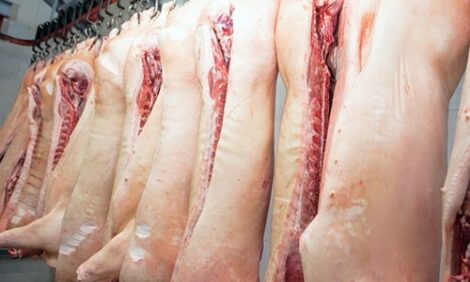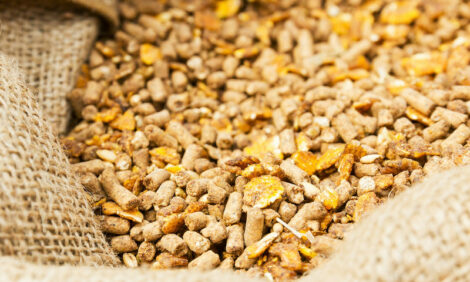



Smithfield Buys Farmland?
CANADA - Jim Long's Weekly Pork Commentary this week focuses on Smithfield Foods attempt to purchase the bankrupt Farmland Foods hog processing business. Jim Long President, Baconmaker Genetics / Wood Lynn Farms, Inc. |
A higher, competing offer could be made in the next couple of months to the bankruptcy court that, if acceptable, could trump Smithfield's current bid. With completion of the Farmland purchase, Smithfield Foods would control approximately 30% of the U.S. hog slaughter capacity (120-130,000 hd/day. Some observations:
- The sale would end the existence of Farmland, not long ago the largest farmers' co-op in the United States with sales over $6 billion/yr.
- Smithfield's intentions are to keep Farmland's existing plants operating at Monmouth, Illinois; Denison, Iowa; and Crete, Nebraska.
- Smithfield's purchase of Farmland Foods demonstrates very clearly their commitment to the U.S. pork industry. Without the continued slaughter capacity of bankrupt Farmland there could be a severe slaughter capacity shortage this fall that would have resulted in lower than expected hog prices.
- Packer margin levels make slaughtering hogs a tough business. No new plant has been built in the U.S. since Seaboard's in Guymon, Oklahoma a decade ago. Of course, continuing modernization has occurred in most, if not all, existing plants but the lack of new slaughter facilities is a reflection of existing and potential returns. The existing slaughter capacity has to be maintained---and it might be an oversimplification---but Farmland didn't go broke by making too much money. The industry needs the Farmland plants to operate and if it is Smithfield who does so, so be it.
Packer Contracts
There is speculation that producers' packer contracts (ledgers, cost-plus, windows etc) have retarded the breeding herd liquidation by shifting producer cash flow shortfalls onto packers. Now, though, we could be approaching a new era of disappearing packer agreements.
Our understanding is there will be few, if any, contracts (ledgers, cost-plus, windows etc) offered or renewed. Too many negative ledgers with large debts have been defaulted on. And cost-plus contracts have generally, over the life of the contracts, resulted in packers paying more than they would have on the open market or shackle contracts.
Packing industry accountants are having no problem rationalizing the elimination of these contracts. With their demise, the buffer many producers have had will be gone. Bankers who demand contracts as a prerequisite for loans for new sow facilities won't get them. Production that was sustained by these risk contracts could be diminished.
We don't know what the effects of diminished packer contracts will be. But whether it is coincidental or cause-and-effect, it is fair to say that the industry, as a whole, has made little money since packer risk contracts began.
Mad Cow (BSE) Update
The export of cattle and beef from Canada to the U.S. and many other countries is still banned due to mad cow (BSE). This past week:
- Japan is not satisfied Canada's BSE monitoring system is adequate. Japan continues to prevent the import of Canadian beef but, moreover, threatens to ban U.S. beef if Canadian beef is allowed into the U.S.
- Japan had mad cow a few years ago and now tests all its slaughter cattle for BSE. It was with amazement this week that we learned Canada does not allow Japanese beef into Canada due to mad cow! Japan exports only Kobe beef which sells for $500/lb---yes, $500.00 per lb. If you were the Japanese what would you think about the logic of Canadian officials? In Japan they test every animal for mad cow but Canada bans Japanese beef nonetheless. On the other hand, Canada would like Japan to lift its ban on Canadian beef but Canada has 11 million head of cattle and has tested 2000 for BSE.
- In western Canada slaughter steers are selling for 27 cents/lb ($U.S.) Meanwhile slaughter steers are 75 cents/lb in the U.S., a difference of well over $500/hd.
- In the past we've talked about retail margins and the surreal power of food retailers. In most stores in Canada the retail beef price has not declined and neither has consumer demand. This is a nice little retail windfall and an example of vertical food coordination at its best. In the meantime the U.S. Agriculture Department has given no timetable for the border being opened. We have expected, since May, it would be 90 to 120 days.
Markets
Vs year ago, U.S. hog slaughter has run half of 1% less since the first of June. USDA's June 1 Hogs & Pigs Report indicated 1% fewer 180 lb-plus pigs than year ago. These are the hogs we've been slaughtering since the Report. USDA projected the next weight category of pigs (120-180 lbs) would be -2% year ago.
There have been more pigs being marketed than expected. Reasons for this might include:
- The cattle problem in Canada due to mad cow could have pushed extra hogs to the U.S. for slaughter.
- Relative to the seasonal norm, weather has been cool.
- We expect fewer large hogs have died from heat stress in barns and in transit.
- The weather has not slowed down growth as much as could be expected.
On a positive note, even though pork production this year is running higher than a year ago (+2.3% this week) prices have been 5-10 cents higher than last year. Though we all question demand issues, the fact is more pork available is still bringing more money for hogs than a year ago.
| Published with permission from |
Information provided by |
Source: Jim Long, www.baconmaker.com. Reproduced courtesy Farms.com - 1st July 2003








